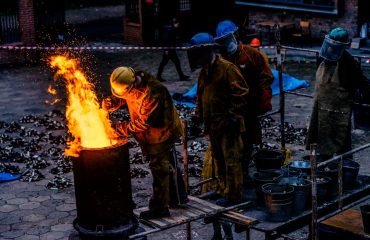The steel industry, a cornerstone of global infrastructure, is undergoing a dramatic transformation. Digitalization is no longer a futuristic concept but a vital necessity for survival and growth. Digital steel platforms are at the heart of this revolution, offering unprecedented levels of efficiency, sustainability, and profitability. Let’s delve into the key trends shaping the future of this crucial sector.
1. AI-Powered Optimization and Predictive Maintenance
Artificial intelligence (AI) is revolutionizing steel production processes. AI algorithms can analyze vast amounts of data from various sources – sensors on machinery, production lines, and even market trends – to optimize every stage of the steelmaking process. This includes:
- Predictive Maintenance: AI can predict equipment failures before they occur, minimizing downtime and reducing maintenance costs. By analyzing patterns in sensor data, AI can identify potential problems and schedule maintenance proactively, preventing costly disruptions.
- Process Optimization: AI can fine-tune parameters like temperature, pressure, and chemical composition to maximize yield, improve product quality, and reduce energy consumption. This leads to significant cost savings and increased efficiency.
- Quality Control: AI-powered vision systems can inspect steel products for defects with greater speed and accuracy than human inspectors, ensuring consistent high quality and reducing waste.
The implementation of AI requires significant investment in data infrastructure and skilled personnel, but the long-term benefits far outweigh the initial costs.
2. Blockchain Technology for Enhanced Traceability and Security
Blockchain technology offers a secure and transparent way to track steel products throughout their entire lifecycle, from raw material sourcing to final delivery. This enhanced traceability provides several advantages:
- Supply Chain Transparency: Every step in the steel’s journey is recorded on the blockchain, making it easy to verify the origin of materials, ensure compliance with regulations, and combat counterfeiting.
- Improved Security: The decentralized nature of blockchain makes it highly resistant to fraud and data manipulation, enhancing the security and reliability of the supply chain.
- Enhanced Sustainability: Blockchain can facilitate the verification of sustainable sourcing practices, allowing companies to demonstrate their commitment to environmental responsibility and meet increasing consumer demand for ethically produced steel.
While the adoption of blockchain in the steel industry is still in its early stages, its potential to revolutionize supply chain management is undeniable.
3. The Rise of Digital Twins for Virtual Steelmaking
Digital twins are virtual representations of physical assets or processes. In the steel industry, digital twins are being used to simulate and optimize steelmaking processes before they are implemented in the real world. This allows for:
- Improved Design and Engineering: Digital twins can be used to test different designs and operating parameters, identifying potential problems and optimizing performance before any physical changes are made.
- Reduced Risk and Downtime: By simulating potential failures and maintenance scenarios, companies can reduce the risk of unexpected downtime and optimize maintenance schedules.
- Enhanced Training and Collaboration: Digital twins provide a safe and effective environment for training personnel and fostering collaboration between different teams and stakeholders.
The use of digital twins is expected to become increasingly prevalent as the industry continues to embrace digitalization.
4. Sustainable Steel Production and Circular Economy Initiatives
The steel industry is a significant contributor to greenhouse gas emissions. Digital platforms play a crucial role in enabling more sustainable steel production by:
- Optimizing Energy Consumption: AI-powered process optimization can significantly reduce energy consumption during steelmaking, lowering carbon emissions.
- Improving Resource Efficiency: Digital tools can help optimize the use of raw materials, reducing waste and minimizing environmental impact.
- Facilitating the Circular Economy: Digital platforms can track and manage the recycling of steel scrap, promoting a circular economy model and reducing the need for virgin materials.
Sustainability is no longer a niche concern but a business imperative, and digital platforms are essential for achieving the industry’s sustainability goals.
5. The Importance of Data Security and Cybersecurity in Digital Steel Platforms
As steel companies increasingly rely on digital platforms to manage their operations, data security and cybersecurity become paramount. Protecting sensitive data from cyber threats is crucial to maintaining business continuity and protecting intellectual property. This involves:
- Robust Cybersecurity Measures: Implementing strong cybersecurity protocols, including firewalls, intrusion detection systems, and regular security audits, is essential.
- Data Encryption: Encrypting sensitive data both in transit and at rest helps to protect it from unauthorized access.
- Employee Training: Educating employees about cybersecurity threats and best practices is crucial to preventing human error, a major source of security breaches.
Investing in robust cybersecurity measures is not just a cost; it’s an investment in the long-term security and resilience of the business.
The future of the steel industry is inextricably linked to the adoption and advancement of digital steel platforms. By embracing these trends, steel companies can unlock significant opportunities for increased efficiency, sustainability, and profitability, forging a brighter and more sustainable future for the industry.
SEO Tags:
digital steel platforms, steel industry 4.0, AI in steel manufacturing, blockchain steel supply chain, sustainable steel production




